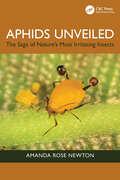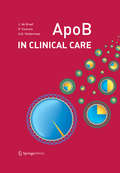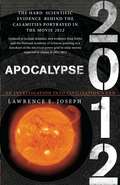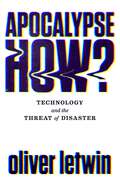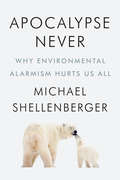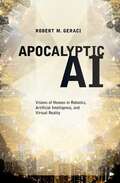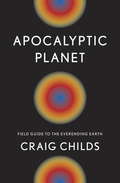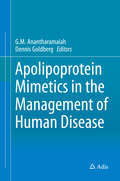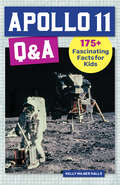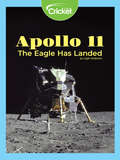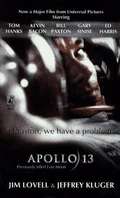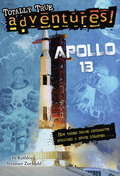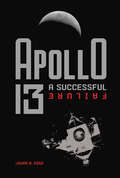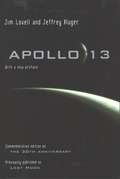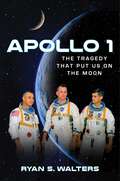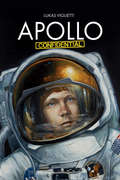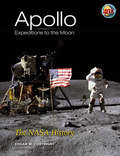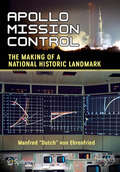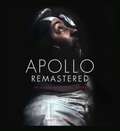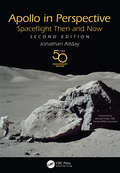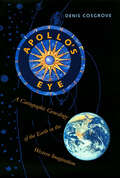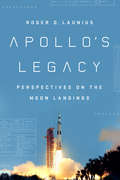- Table View
- List View
Aphids Unveiled: The Saga of Nature's Most Irritating Insects
by Amanda Rose NewtonAphids Unveiled: The Saga of Nature's Most Irritating Insects explores the curious journey of these tiny insects from humble beginnings to becoming the most obnoxious pests for farmers and home gardeners alike. With a witty narrative style and a touch of humor, the book aims to engage readers with the quirky behaviors, social structures, and survival strategies of aphids, all while unraveling the reasons behind their impact on agriculture and horticulture.Amanda Rose Newton brings over a decade of experience in both the horticulture and pest control worlds to write for a broad audience, from gardening enthusiasts seeking effective pest management strategies to science enthusiasts interested in a lighthearted exploration of the natural world. As an entomologist and professor, her writing uniquely blends expertise with a passion for storytelling, ensuring Aphids Unveiled is not only informative but also an entertaining read.
Aphids as Crop Pests
by Richard Harrington Helmut F. EmdenAphids are among the major global pest groups, causing serious economic damage to many food and commodity crops in most parts of the world. This revision and update of the well-received first edition published ten years ago reflects the expansion of research in genomics, endosymbionts and semiochemicals, as well as the shift from control of aphids with insecticides to a more integrated approach imposed by increasing resistance in the aphids and government restrictions on pesticides. The book remains a comprehensive and up-to-date reference work on the biology of aphids, the various methods of controlling them and the progress of integrated pest management as illustrated by ten case histories. Helmut van Emden is Emeritus Professor of Horticulture at the University of Reading, UK. He has researched on aphids for over 50 years and has wide international experience, including in the tropics. Richard Harrington retired in 2015 as Head of the Rothamsted Insect Survey, with which he worked for 36 years on aphid monitoring and forecasting. He led the EU project "EXAMINE" (Exploitation of Aphid Monitoring In Europe) which brought together colleagues involved in aphid monitoring throughout Europe and beyond.
ApoB in Clinical Care
by Jacqueline Graaf Patrick Couture Allan D. SnidermanNow, based on the apoB algorithm, that is outlined and illustrated in this book, family physicians as well as cardiologists, endocrinologists and internists will be able to easily and accurately identify and treat these disorders. The apoB dyslipoproteinemias are major common causes of vascular disease. But until now, accurate diagnosis has not been possible. With just total cholesterol, triglycerides and apoB, all the apoB dyslipoproteinemias, with the exception of elevated Lp(a), can be identified using the apoB algorithm. The apoB app, which incorporates this algorithm, is available from both Apple and Android and is free.
Apocalypse 2012: A Scientific Investigation into Civilization's End
by Lawrence E. JosephDon't look up. It won't help. You can't get out of the way, you can't dig a hole deep enough to hide. The end is coming, and there's nothing you can do about it. So why read this book? Because you can't look away when not just the religious fanatics are saying we're all going to be destroyed but the scientists are in on the act too. Here's what they're saying: We're a million years over due for a mass extinction. The sun at radiation minimum is acting much worse than at solar maximum, and one misdirected spewing of plasma could fry us in an instant. The magnetic field--which shields us from harmful radiation--is developing a mysterious crack. Our solar system is entering an energetically hostile part of the galaxy. The Yellowstone supervolcano is getting ready to blow, and if it does, we can look forward to nuclear winter and 90 percent annihilation. The Maya, the world's greatest timekeepers ever, say it's all going to stop on December 21, 2012. So, see? There's nothing you can do, but you might as well sit back and enjoy the show. You'll get a good chuckle. That's why you should read this book. Dear Reader, If there were a chance that opening this book could set off a chain of events that would lead to Apocalypse, to the end of Life as we know it, would you be tempted? Finger poised uncertainly above the flashing red button? How about if the Apocalypse promised to result in a new age of enlightenment, a Heaven on Earth like never before? Personally, I'll take the security of my cozy life over a chance at nirvana. But status quo may no longer be an option, for any of us. This book will convince you that there is a non-negligible chance that the year 2012 will be more tumultuous, catastrophic, and, quite possibly, revelatory, than any other year in human history. Parts of this book are best read with a bowl of popcorn: looking into the jaws of a great white shark in search of the meaning of death; touring a picturesque Guatemalan town with Mayan shaman just weeks before it is utterly destroyed. Other sections go better with a tranquilizer, such as the impending eruption of the Yellowstone supervolcano, or the mass extinction headed our way--on the scale of the great collision that destroyed the dinosaurs and 70 percent of all other species, our best scientists contend that it's now overdue. Nail-biters should beware the fact that the next peak in the sunspot cycle, due in 2012, is widely expected to set records for the number and intensity of solar storms pummeling the Earth with radiation and igniting natural calamities such as earthquakes, volcanoes, and Katrina-sized hurricanes. And that our entire solar system appears to be moving into a dangerous interstellar energy cloud. Is it a coincidence that the burgeoning war between Christianity and Islam seems hell-bent for Armageddon? Or that numerous other religions, philosophies, and cultural traditions are signaling that the end is near, with 2012 emerging as the consensus target date? A new era is about to be born, with all the pain and blood and joy and release that birth naturally entails. Facing oblivion, or at least mega-metamorphosis, is something that few of us are emotionally prepared to do. Thus my excuse for the gallows humor that pervades this story. In a memorable Mary Tyler Moore episode, Mary cracks up laughing at the funeral of Chuckles the Clown who, dressed as a peanut while marching in a parade, was shucked to death by an elephant. If Mary can giggle in the face of death, so can we. With kind regards, Lawrence E. Joseph.
Apocalypse How?: Technology and the Threat of Disaster
by Oliver LetwinAs the world becomes better connected and we grow ever more dependent on technology, the risks to our infrastructure are multiplying. Whether it's a hostile state striking the national grid (like Russia did with Ukraine in 2016) or a freak solar storm, our systems have become so interlinked that if one part goes down the rest topple like dominoes.In this groundbreaking book, former government minister Oliver Letwin looks ten years into the future and imagines a UK in which the national grid has collapsed. Reliant on the internet, automated electric cars, voice-over IP, GPS, and the internet of things, law and order would disintegrate. Taking us from high-level government meetings to elderly citizens waiting in vain for their carers, this book is a wake up call for why we should question our unshakeable faith in technology. But it's much more than that: Letwin uses his vast experience in government to outline how businesses and government should respond to catastrophic black swan events that seem distant and implausible - until they occur.
Apocalypse Never: Why Environmental Alarmism Hurts Us All
by Michael ShellenbergerClimate change is real but it’s not the end of the world. It is not even our most serious environmental problem. Michael Shellenberger has been fighting for a greener planet for decades. He helped save the world’s last unprotected redwoods. He co-created the predecessor to today’s Green New Deal. And he led a successful effort by climate scientists and activists to keep nuclear plants operating, preventing a spike of emissions.But in 2019, as some claimed “billions of people are going to die,” contributing to rising anxiety, including among adolescents, Shellenberger decided that, as a lifelong environmental activist, leading energy expert, and father of a teenage daughter, he needed to speak out to separate science from fiction.Despite decades of news media attention, many remain ignorant of basic facts. Carbon emissions peaked and have been declining in most developed nations for over a decade. Deaths from extreme weather, even in poor nations, declined 80 percent over the last four decades. And the risk of Earth warming to very high temperatures is increasingly unlikely thanks to slowing population growth and abundant natural gas. Curiously, the people who are the most alarmist about the problems also tend to oppose the obvious solutions. What’s really behind the rise of apocalyptic environmentalism? There are powerful financial interests. There are desires for status and power. But most of all there is a desire among supposedly secular people for transcendence. This spiritual impulse can be natural and healthy. But in preaching fear without love, and guilt without redemption, the new religion is failing to satisfy our deepest psychological and existential needs.
Apocalyptic AI: Visions of Heaven in Robotics, Artificial Intelligence, and Virtual Reality
by Robert M. GeraciApocalyptic AI, the hope that we might one day upload our minds into machines or cyberspace and live forever, is a surprisingly wide-spread and influential idea, affecting everything from the world view of online gamers to government research funding and philosophical thought. In Apocalyptic AI, Robert Geraci offers the first serious account of this "cyber-theology" and the people who promote it. Drawing on interviews with roboticists and AI researchers and with devotees of the online game Second Life, among others, Geraci illuminates the ideas of such advocates of Apocalyptic AI as Hans Moravec and Ray Kurzweil. He reveals that the rhetoric of Apocalyptic AI is strikingly similar to that of the apocalyptic traditions of Judaism and Christianity. In both systems, the believer is trapped in a dualistic universe and expects a resolution in which he or she will be translated to a transcendent new world and live forever in a glorified new body. Equally important, Geraci shows how this worldview shapes our culture. Apocalyptic AI has become a powerful force in modern culture. In this superb volume, he shines a light on this belief system, revealing what it is and how it is changing society.
Apocalyptic Planet
by Craig ChildsThe earth has died many times, and it always comes back looking different. In an exhilarating, surprising exploration of our planet, Craig Childs takes readers on a firsthand journey through apocalypse, touching the truth behind the speculation. Apocalyptic Planet is a combination of science and adventure that reveals the ways in which our world is constantly moving toward its end and how we can change our place within the cycles and episodes that rule it. In this riveting narrative, Childs makes clear that ours is not a stable planet, that it is prone to sudden, violent natural disasters and extremes of climate. Alternate futures, many not so pretty, are constantly waiting in the wings. Childs refutes the idea of an apocalyptic end to the earth and finds clues to its more inevitable end in some of the most physically challenging places on the globe. He travels from the deserts of Chile, the driest in the world, to the genetic wasteland of central Iowa to the site of the drowned land bridge of the Bering Sea, uncovering the micro-cataclysms that predict the macro: forthcoming ice ages, super-volcanoes, and the conclusion of planetary life cycles. Childs delivers a sensual feast in his descriptions of the natural world and a bounty of unequivocal science that provides us with an unprecedented understanding of our future.
Apocynaceae Plants: Ethnobotany, Phytochemistry, Bioactivity and Biotechnological Advances
by Ravindra H. Patil Vijay L. Maheshwari Mohini P. PatilThis book provides a concise overview of the Apocynaceae plant family, focusing on its morphology, diversity, ethnopharmacology, phytochemistry, and biological activities. It explores biotechnological advances in large-scale production of therapeutic bioactive compounds and conservation efforts using plant tissue culture. The family Apocynaceae is one of the largest and important families in angiosperm, with several members having medicinal properties used to treat various ailments. Most of them are consumed as food by tribal people, while a few plants are used as a source of poison, insecticides, gum, and many other important products. Members of this family are rich in alkaloids, terpenoids, steroids, flavonoids, glycosides, simple phenols, lactones and hydrocarbons. Other compounds such as sterols, lignans, and sugars have also been systematically studied. Extracts and isolated compounds from Apocynaceae members exhibit antioxidant, anti-inflammatory, antimicrobial, and cytotoxic activities. Notable plants like Holarrhena antidysenterica, Rauvolfia serpentina, Carissa carandas, and Tabernaemontana divaricata have been extensively researched. The family presents a diverse range of bioactive compounds with medicinal and pharmacological properties, holding promise for future applications. The book also covers endophytic microorganisms with their diversity, biological activities in Apocynaceae plants. It also highlights the role of endophytes in conservation of Apocynaceae plants. By identifying existing knowledge gaps, it aims to inspire further research in the field, making it a valuable resource for students and researchers in Life Sciences, agriculture, medicine, and pharmaceutical sciences.
Apolipoprotein Mimetics in the Management of Human Disease
by G. M. Anantharamaiah Dennis GoldbergThis comprehensive book provides not only the stages in the development of this unique and specialized field but also updates on the current state of research and development of apolipoprotein mimetics as therapeutic modalities for various lipid-mediated disorders. The book consists of 11 chapters all written by leading scientists from well-reputed laboratories in the USA. After an introduction by Dr. Godfrey Getz, Professor of Medicine at the University of Chicago and the Associate Editor of the Journal Lipid Research, the book presents a narration of how a theory can lead to the discovery of treatment modalities to several devastating diseases such as diabetes, Alzheimer's disease, arthritis; asthma; atherosclerosis, chronic rejection of transplanted hearts and cancer. Present therapies for most of these diseases are not adequate. Using the models of two long anti-atherogenic and anti-inflammatory proteins (apolipoprotein A-I and apolipoprotein E with 243 and 299 amino acids, respectively) short mimetic peptides of 18 to 28 amino acid residues in length, which can be produced either synthetically or genetically in edible fruits and vegetables, have been shown to exert profound biological effects in a large number of animal models of diseases. The book also presents novel ideas, highly unexpected mechanisms of action in animal models and even in initial clinical studies in humans, which can lead to additional improvements in basic and clinical research in biological science. All the chapters are written by experts in their respective fields who have contributed immensely to the literature. This is the first compendium of this growing field presented in the form of a book.
Apollo 11 Q&A: 175+ Fascinating Facts for Kids (History Q&A)
by Kelly Milner Halls175+ fascinating facts that teach kids ages 8 to 12 how we got to the moon From cube-shaped astronaut foods to the famous moon walk, there are so many incredible things for kids to learn about the Apollo 11 mission. This engaging guide introduces kids to the legacy of Apollo 11 through short, fun Q&As. They'll see how awesome learning can be as they read about spaceships, astronauts, space suits, and more—one easy-to-understand answer at a time. Go beyond other Apollo 11 books for kids with: New ways to learn—Launch kids into the history of the Apollo 11 mission with Q&As, true or false questions, and fun facts. Shareable history—This book is packed full of bite-sized bits of history that are both memorable and exciting for kids to tell their friends and family. A complete overview—From the start of the space race to the ways the Apollo 11 mission still affects modern space travel, kids will get a comprehensive look at America's space program. Spark a lifelong love of history in young astronauts with this top choice in space books for kids.
Apollo 11: The Eagle Has Landed
by Leigh AndersonHave you ever looked into the night sky and wished that you could walk on the Moon? Find about what it is like from the astronauts that were first to do it! Learn about how Neil Armstrong, Edwin Aldrin, and Michael Collins traveled into space and created history in 1969, and what it was like to take those famous first steps that made “one giant leap for mankind."
Apollo 13
by Jim Lovell Jeffrey KlugerDramatic story of near disaster and rescue of Apollo 13 en route to the moon.
Apollo 13 (Totally True Adventures)
by Kathleen Weidner Zoehfeld Wesley LoweCould you survive an outer-space disaster? Aspiring astronauts and young explorers will love this out-of-this-world Totally True Adventure. Astronauts Jim Lovell, Jack Swigert, and Fred Haise blasted off for the Moon on April 11, 1970. But after a disastrous explosion damaged their spacecraft, the three men had only one goal: to get back home safely. This informational text makes space travel exciting and accessible for younger readers and features illustrations, photographs, a map, and additional Story Behind the Story facts. Perfect for readers of the I Survived series and the Who Was series, Totally True Adventures are captivating nonfiction stories with not-to-be-missed bonus content.
Apollo 13: A Successful Failure
by Laura B. Edge"Houston, we've had a problem." On April 13, 1970, the three astronauts aboard the Apollo 13 spacecraft were headed to the moon when a sudden explosion rocked the ship. Oxygen levels began depleting rapidly. Electrical power began to fail. Astronauts James Lovell, Jack Swigert, and Fred Haise were about to be stranded in the inky void of outer space. The mission to the moon was scrapped. Now, Apollo 13's only goal was to bring the crew home. With the damaged spacecraft hurtling towards the moon at roughly six thousand miles per hour, there was little hope of success. But the astronauts and mission control were fully prepared to do whatever it took to return the crew to Earth. This space disaster occurred at the peak of the United States' Space Race against the Soviet Union. But for four days in 1970, the two nations put aside their differences, and the entire world watched the skies, hoping and praying the astronauts would return safely. As missions to Mars and commercial space flight become a reality, the time is now to be reminded of our common humanity, of how rivals can work together and support each other towards a shared goal. Because no matter what happens or where we travel, we all call Earth home.
Apollo 13: Lost Moon
by Jeffrey Kluger James LovellIn April 1970, during the glory days of the Apollo space program, NASA sent Navy Captain Jim Lovell and two other astronauts on America's fifth mission to the moon. Only fifty-five hours into the flight of Apollo 13, disaster struck: a mysterious explosion rocked the ship, and soon its oxygen and power began draining away. Written with all the color and drama of the best fiction, APOLLO 13 (previously published as Lost Moon) tells the full story of the moon shot that almost ended in catastrophe. Minutes after the explosion, the three astronauts are forced to abandon the main ship for the lunar module, a tiny craft designed to keep two men alive for just two days. As the hours tick away, the narrative shifts from the crippled spacecraft to Mission Control, from engineers searching desperately for a way to fix the ship to Lovell's wife and children praying for his safe return. The entire nation watches as one crisis after another is met and overcome. By the time the ship splashes down in the Pacific, we understand why the heroic effort to rescue Lovell and his crew is considered by many to be NASA's finest hour.Now, thirty years after the launch of the mission, Jim Lovell and coauthor Jeffrey Kluger add a new preface and never-before-seen photographs to Apollo 13. In their preface, they offer an incisive look at America's waxing and waning love affair with space exploration during the past three decades, culminating only recently when the Apollo 13 spacecraft itself, long consigned to an aviation museum outside Paris, was at last returned to its rightful home in the United States. As inspiring today as it was thirty years ago, the story of Apollo 13 is a timeless tribute to the enduring American spirit and sparkling individual heroism.
Apollo 1: The Tragedy That Put Us on the Moon
by Ryan S. WaltersOn January 27, 1967, astronauts Gus Grissom, Ed White, and Roger Chaffee climbed into a new spacecraft perched atop a large Saturn rocket at Kennedy Space Center in Florida for a routine dress rehearsal of their upcoming launch into orbit, then less than a month away. All three astronauts were experienced pilots and had dreams of one day walking on the moon. But little did they know, nor did anyone else, that once they entered the spacecraft that cold winter day they would never leave it alive. The Apollo program would be perilously close to failure before it ever got off the ground. But rather than dooming the space program, this tragedy caused the spacecraft to be completely overhauled, creating a stellar flying machine to achieve the program&’s primary goal: putting man on the moon. Apollo 1 is a candid portrayal of the astronauts, the disaster that killed them, and its aftermath. In it, readers will learn: How the Apollo 1 spacecraft was doomed from the start, with miles of uninsulated wiring and tons of flammable materials in a pure oxygen atmosphere, along with a hatch that wouldn&’t open How, due to political pressure, the government contract to build the Apollo 1 craft went to a bidder with an inferior plan How public opinion polls were beginning to turn against the space program before the tragedy and got much worse after Apollo 1 is about America fulfilling its destiny of man setting foot on the moon. It&’s also about the three American heroes who lost their lives in the tragedy, but whose lives were not lost in vain.
Apollo Confidential: Memories of Men On the Moon
by Lukas VigliettiThe inside stories of the Apollo program and the live of astronauts, as told to the author by the men themselves—with a forward by astronaut Charlie Duke. Between 1969 and 1972, twelve people walked on the surface of the Moon. Twelve others flew over its majestic surface. They were the sons of ordinary individuals. But they believed anything was possible―and they proved it to the entire world. Fascinated by these men—heroes such as Alan Shepard, Neil Armstrong, Buzz Aldrin, and many others—airline pilot Lukas Viglietti personally recorded their testimonies, becoming a close friend and confidant to many of them in the process. Now he shares his exclusive and unprecedented insight into their adventures and the Apollo program overall in Apollo Confidential.
Apollo Expeditions to the Moon: The NASA History
by Edgar M. CortrightDiscover the thrilling inside story of the Apollo program with this new commemorative edition of an official NASA publication. This volume features essays by the program's participants--engineers, administrators, and astronauts--that recall the unprecedented challenges associated with putting men on the Moon. Written in direct, jargon-free language, this compelling adventure story features scores of black-and-white illustrations, in addition to more than 160 dazzling color photographs."A triumph of organization as well as daring, the Apollo program reflects the success of a dedicated crew of gifted individuals. This well-rounded survey offers insights into the program's management challenges as well as its engineering feats. Contributors include NASA administrator James E. Webb; Christopher C. Kraft, head of the Mission Control Center; engineer Wernher von Braun; Michael Collins, Buzz Aldrin, Alan Shepard, and other astronauts. Informative, exciting narratives explore the issues that set the United States on the path to the Moon, offer perspectives on the program's legacy, and examine the particulars of individual missions. Journalist Robert Sherrod chronicles the selection and training of astronauts. James Lovell, commander of the ill-fated Apollo 13, recounts the damaged ship's dramatic return to Earth. Geologist and Apollo 17 astronaut Harrison Schmitt discusses the lunar expeditions' rich harvest of scientific information. These and other captivating firsthand accounts form an ideal introduction to the historic U.S. space program as well as fascinating reading for Apollo enthusiasts of all ages.
Apollo Mission Control: The Making of a National Historic Landmark (Springer Praxis Books)
by Manfred "Dutch" von EhrenfriedThis book describes the history of this now iconic room which represents America’s space program during the Gemini, Apollo, Skylab, Apollo-Soyuz and early Space Shuttle eras. It is now a National Historic Landmark and is being restored to a level which represents the day the flight control teams walked out after the last lunar landing missions. The book is dedicated to the estimated 3,000 men and women who supported the flights and tells the story from their perspective. It describes the rooms of people supporting this control center; those rooms of engineers, analysts and scientists most people never knew about. Some called it a “shrine” and some called it a “cathedral.” Now it will be restored to its former glory and soon thousands will be able to view the place where America flew to the moon.
Apollo Remastered: The Ultimate Photographic Record
by Andy SaundersThis definitive photographic book about the Apollo missions reveals hundreds of extraordinary, newly-restored, and all-new images from the NASA archives that provide a never-before-seen perspective on the Apollo endeavors more than 50 years after humankind first stepped foot on the moon. In Houston, Texas, there is a frozen vault that preserves the original NASA photographic film of the Apollo missions. For half a century, almost every image of the Moon landings publicly available was produced from a lower-quality copy of these frozen originals. Over the last few years, NASA image restorer Andy Saunders has been working hard. Taking newly available digital scans and applying pain-staking care and cutting-edge enhancement techniques, he has created the highest quality Apollo photographs ever produced. Never-before-seen spacewalks and crystal-clear portraits of astronauts in their spacecraft, along with startling new visions of the Earth and the Moon, offer astounding new insight into one of our greatest endeavors. This is the definitive record of all Apollo missions and a mesmerizing, high-definition journey into the unknown. And, now, Saunders's photographs bring the story of the Apollo missions to life in the new film The Moonwalkers: A Journey with Tom Hanks.
Apollo in Perspective: Spaceflight Then and Now
by Jonathan AlldayChoice Highly Recommended Title, January 2020 This special edition of Apollo in Perspective marks the 50th anniversary of the Apollo 11 Moon landing in 1969. Updated and revised throughout, it takes a retrospective look at the Apollo space program and the technology that was used to land a man on the Moon. In addition, there is a new chapter looking forward to the future of contemporary spaceflight in returning to the Moon (project Artemis) and going on to Mars. Using simple illustrations and school-level mathematics, it explains the basic physics and technology of spaceflight, from how rockets work to the dynamics of orbits and how to simulate gravity in a rotating spacecraft. A mathematical appendix shows how some of the formulas can be derived. This is an excellent introduction to astronautics for anyone interested in space and spaceflight. Features: Accessible, written in a friendly and informal style Contains real-world examples Updated throughout, with new chapters on the Apollo missions and the immediate future of human spaceflight From the Foreword"I am sure there is a woman or a man alive today who will land on the Moon and on Mars. This book will certainly help them be ready for such a journey. Most importantly, it explains not only what happened 50 years ago, but how the Apollo missions happened, and the science that is required to do it again, or to go further, to Mars. If the reader is younger, still in school and perhaps considering the sciences, this book will introduce ideas that will help you choose the subjects to study which can help you to make your space travel a reality. For others, the book will be an exciting and thought provoking read that gives a vision of the near future in space, which all of us on planet Earth will be able to enjoy as the adventure unfolds."— Michael Foale, CBE, former-NASA astronaut
Apollo's Eye: A Cartographic Genealogy of the Earth in the Western Imagination
by Carmen P. CosgroveWinner of the Association of American Publishers Professional and Scholarly Publishing Award in Geography & Earth Sciences"Earthbound humans are unable to embrace more than a tiny part of the planetary surface. But in their imagination they can grasp the whole of the earth, as a surface or a solid body, to locate it within infinities of space and to communicate and share images of it."—from the Preface Long before we had the ability to photograph the earth from space—to see our planet as it would be seen by the Greek god Apollo—images of the earth as a globe had captured popular imagination. In Apollo's Eye, geographer Denis Cosgrove examines the historical implications for the West of conceiving and representing the earth as a globe: a unified, spherical body. Cosgrove traces how ideas of globalism and globalization have shifted historically in relation to changing images of the earth, from antiquity to the Space Age. He connects the evolving image of a unified globe to politically powerful conceptions of human unity.
Apollo's Eye: A Cartographic Genealogy of the Earth in the Western Imagination
by Denis CosgroveThis award-winning science history explores our evolving image of the globe—and how it has shifted our relationship to the world.Long before we had the ability to photograph the earth from space—to see our planet as it would be seen by the Greek god Apollo—images of the earth as a globe had captured popular imagination. In Apollo’s Eye, geographer Denis Cosgrove examines the historical implications for the West of conceiving and representing the earth as a globe: a unified, spherical body. Cosgrove traces how ideas of globalism and globalization have shifted historically in relation to changing images of the earth, from antiquity to the Space Age. He connects the evolving image of a unified globe to politically powerful conceptions of human unity.Winner of the Association of American Publishers Professional and Scholarly Publishing Award in Geography & Earth Sciences
Apollo's Legacy: Perspectives on the Moon Landings
by Roger D. LauniusAn all-encompassing look at the history and enduring impact of the Apollo space programIn Apollo's Legacy, space historian Roger D. Launius explores the many-faceted stories told about the meaning of the Apollo program and how it forever altered American society. The Apollo missions marked the first time human beings left Earth's orbit and visited another world, and thus they loom large in our collective memory. Many have detailed the exciting events of the Apollo program, but Launius offers unique insight into its legacy as seen through multiple perspectives. He surveys a wide range of viewpoints and narratives, both positive and negative, surrounding the program. These include the argument that Apollo epitomizes American technological--and political--progress; technological and scientific advances garnered from the program; critiques from both sides of the political spectrum about the program's expenses; and even conspiracy theories and denials of the program's very existence. Throughout the book, Launius weaves in stories from important moments in Apollo's history to draw readers into his analysis. Apollo's Legacy is a must-read for space buffs interested in new angles on a beloved cultural moment and those seeking a historic perspective on the Apollo program.
